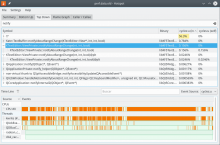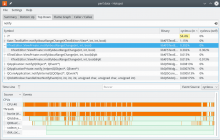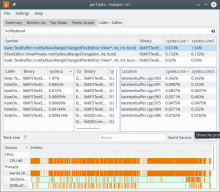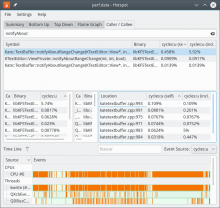Calculate the list of keys of a hash table is quite expensive.
It is cheaper to keep that list and change it when a view is created or removed.
Details
- Reviewers
cullmann mwolff - Group Reviewers
Kate - Commits
- R39:90157a222b5e: optimization of KTextEditor::DocumentPrivate::views()
Run kwrite and paste a relative long text several times and then undo until the text is empty, with only one view.
Before:
After: it uses 19% of cpu instructions in in Kate::TextBuffer::notifyAboutRangeChange
Diff Detail
- Repository
- R39 KTextEditor
- Lint
Automatic diff as part of commit; lint not applicable. - Unit
Automatic diff as part of commit; unit tests not applicable.
If you have benchmark results for that, I have no issues with the idea.
Thought I think you only need to update the cache in add/removeView, not in KTextEditor::DocumentPrivate::createView
Oh and again: please start using perf/hotspot instead of callgrind. Really, the performance numbers you get from callgrind are just *instructions*! It doesn't mean "65% of CPU". It means 65% of the instructions.
You are doing such good work with profiling and optimizing software, it would be so much better if you'd use the correct tools too!
Add and remove from the list.
About the tools I use to profile:
- I'm used to use slow machines, I have no problems running under valgrind.
- When I can run a program and I'm able to repeat the workload that produces high cpu usage or slowness, I do like to use callgrind/kcachegrind, just because I get inclusive costs.
- When a program gets slow after some time running or under some unexpected circumstances, yes I use perf, because I do not need to restart the program and I can do live measurements.
- But I do love the kcachegrind view of the % of instructions for every method within the source code.
In any case, the hotspot results pasting 10 times and undoing:
Before:
After:
But the hotspot screenshot clearly shows that you are spending time on optimizing things that are barely noticeable. You have optimized a function that consumes 0.3% of the CPU cycles. It now consumes only ~0.15%, at the cost of slightly higher memory consumption.
This is the real cost. The instruction numbers reported by callgrind paint a very different picture (22.6% vs. 5.5%). But that's not what actually matters, the cycle cost is way more important.
Also note that hotspot shows inclusive costs. You should get used to it, most notably have a look at the flamegraph and get acquainted with that way to visualize profiling costs.
Actually, no. Ignore what I said. The pictures you are showing are pretty meaningless. Did you run perf with --call-graph dwarf? Better look at the flamegraph and search for the function you are interested in (Kate::TextBuffer::notifyAboutRangeChange) or use the Caller/Callee view to get an aggregated view of your change.
That's not the impression I got running kwrite in live and under a slow machine (valgrind), before I had to wait for the paste to finish, and after the patch not. But kwrite is still slow undoing the paste.
I did run perf record -g, the same test with the patch applied after pasting the text 25 times and undoing with this result:
.The same test (pasting 25 times and undoing) with --call-graph dwarf with this result: , and .
perf record -g produces unusable data files, since it relies on the frame pointer which is usually not available. Use perf record --call-graph dwarf instead. https://phabricator.kde.org/file/data/w4qogv4brtxlc5p5bnwr/PHID-FILE-q62giymcptudpl5m6bt3/kwrite_perf_after_25_dwarf_caller.png shows ~1.5% in notifyAboutRangeChange (inclusively). Is that before or after your patch here?
OK, cool! That clearly shows that this patch _is_ valuable: Before we have ~6% CPU cycle cost, now it's down to 1.5% (inclusively). This is a significant reduction, so I'm all for it.
But note once again the stark difference in these numbers vs. what valgrind reports. Please, try to use perf record --call-graph dwarf + hotspot flamegraphs more in favor of callgrind/kcachegrind. Note that you can even use hotspot's record page for some more features, most notably the off-CPU profiling. This can give you more food for potential optimizations (finding sleep time, I/O, lock contention, ...).
Happy profiling!







